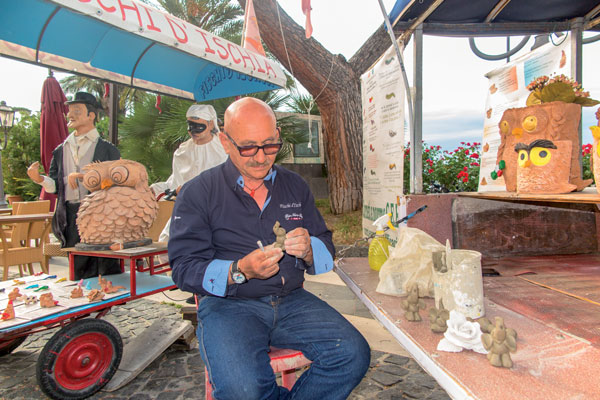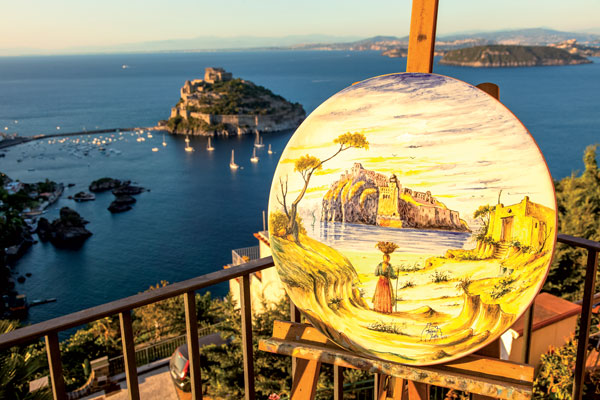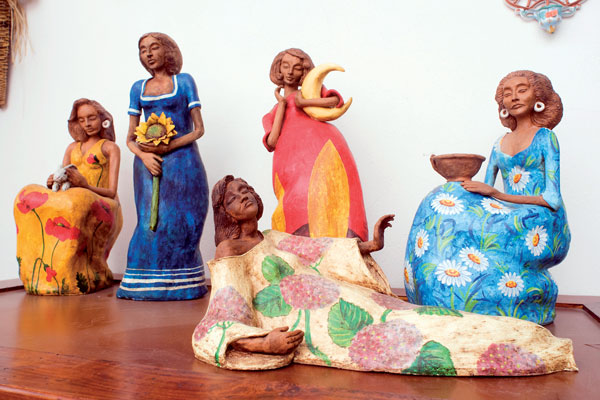Of water and clay, the terrecottes signed by the island of the vasai
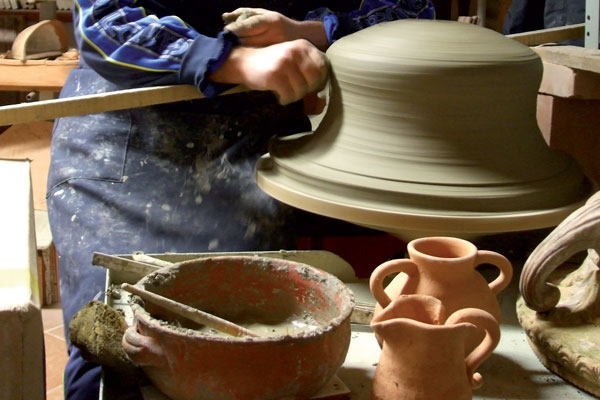
by Isabella Marino*
We will never know its real name. There has been done, Inos, to defeat oblivion. And the time. That signature, placed at the end of the eighth century BC, is the oldest of a craftsman who has come down to us. It tell us the story of an object of everyday use found on the hill of Mazzola, in today’s Lacco Ameno. A few tens of meters, as the crow flies, from the most coastal “keramèikos”, the potters’ quarter discovered since the middle of the last century in the archaeological area under the basilica of Santa Restituta, where also Inos modeled and decorated the local clay.
A Pithecusa, i primi coloni giunti da Eubea avevano trovato condizioni ideali per insediarsi. Tra le quali una grande disponibilità di argilla , di acqua dolce e di legna da ardere, l’ideale per loro, che nella grande isola d’origine avevano una lunga tradizione di produzione della ceramica. Ripresa anche nella nuova terra, dove si erano portati uno strumento d’avanguardia per le lavorazioni del tempo, il tornio, di cui avrebbero trasmesso la tecnologia agli Etruschi e alle altre popolazioni italiche.
Dai primi anni della colonia e ininterrottamente fino all’età ellenistica, il keramèikos nel centro di Pithecusa rimase attivo, tanto che Plinio il Vecchio fa risalire proprio ai “pithoi”, i vasi, il nome greco dell’isola. I forni per la cottura funzionavano a pieno ritmo. L’assortimento era ampio: oggetti di uso domestico, religioso e commerciale, materiali da costruzione, giochi per bambini e qualche pezzo unico di particolare valore. Le forme e le decorazioni recepivano, reinterpretandole in modo originale, quelle di volta in volta di tendenza sia in Grecia che nei principali centri produttivi del Mediterraneo. Dove venivano poi largamente esportate anche le ceramiche pithecusane, protagoniste degli intensi rapporti commerciali intrattenuti dai naviganti locali con le popolazioni rivierasche tra oriente e occidente, non trascurando la Grecia.
Quei forni di diversa epoca, giunti intatti ai nostri giorni, con un vasto corredo di reperti e di scarti di lavorazione, hanno consentito di ricostruire le tecniche produttive arcaiche e di studiare la materia prima locale. E di riconoscere i bolli, i marchi di fabbrica dell’antichità, attraverso i quali è possibile ricomporre il quadro della diffusione dei prodotti “made in Pithecusa” nel Mediterraneo. Soprattutto grandi anfore, che non partivano sempre vuote. Grazie al bollo ZO-ZOEROS è stata attribuita ad una fabbrica pithecusana del III secolo a.C. un’anfora piena di vino rosso isolano, imbarcata su una nave in rotta per il nord-Africa e affondata al largo di Filicudi.
La decadenza di Pithecusa non segnò la fine della produzione figulina, che caratterizzò ininterrottamente l’isola anche nelle epoche successive. Unico territorio nel golfo di Napoli con la disponibilità di grandi depositi di argilla, gli abitanti continuarono a sfruttare le ricche cave nella fascia collinare intorno all’Epomeo. Come quelle del Cretaio, da cui si rifornivano le numerose fabbriche insediate lungo la costa tra Casamicciola e Lacco, ancora prima che quei “casali” si chiamassero così. Un tratto di litorale che il mare ha progressivamente inghiottito, insieme alle botteghe dei vasai medievali e
In Pithecusa, the first settlers arrived from Euboea had found ideal conditions to settle. Among them a great availability of clay, fresh water and firewood. From the early years of the colony the range was wide: objects of domestic, religious and commercial use, building materials, games for children and some unique pieces of particular value. Pithecusan ceramics were also widely exported.
The decadence of Pithecusa did not mark the end of figulina production, which characterized the island without interruption even in the following ages. The only territory in the Gulf of Naples with the availability of large clay deposits, the inhabitants continued to exploit the rich caves in the hillside around Epomeo. Like those of the Cretaio, Casamicciola and Lacco, even before those “hamlets” were called in this way. A stretch of coastline that the sea has gradually engulfed, along with the potters workshops of medieval and more recent eras, heirs faithful to the work processed by the pithecusan ancestors.
Famous for its “cooked clay” even before becoming it in Europe for its thermal waters, with the tourism development of the last century, Casamicciola did not give up its tradition figulina. Instead of mass production for the building industry, the new factories opened to safety from the sea dedicated themselves to producing objects finely decorated for foreigners.
Archaeological Museum of Pithecusae, Villa Arbusto, Lacco Ameno - Tuesday to Sunday 9.00-19.00. Monday closed
“Whistles of colored clay and irony without saving, with a built-in apotropaic sound. From the center of Casamicciola to whistle the name of Ischia around the world with joy.”
Fischi d’Ischia, corso Luigi Manzi 11 (Piazza Marina), Casamicciola Terme
“Beyond the window of the workshop, the favorite model is shown in its amazing beauty.”
Rosario Scotto Di Minico, Via Campagnano 102, Ischia
Research
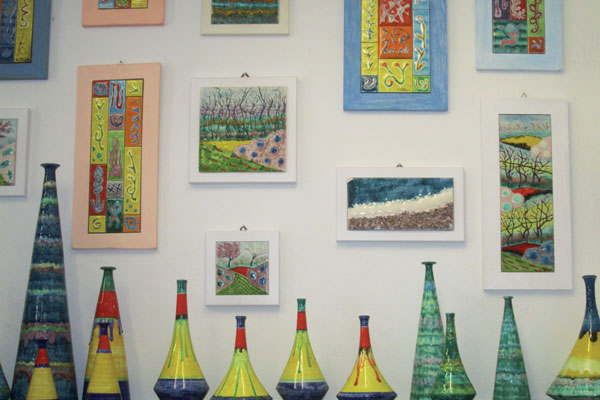
“Ischia is revealed above all in the choice of colors, vivid and never violent, witnesses of a strong identity that innervates the continuous search for innovation”
Ceramiche Cianciarelli, via Luigi Mazzella, Ischia Ponte
“The peculiarities that have made it the ideal place for the production of ceramics since ancient times, have risked to cancel a precious experience of life and work”
Kèramos, via Giovanni Patalano 64, Forio

